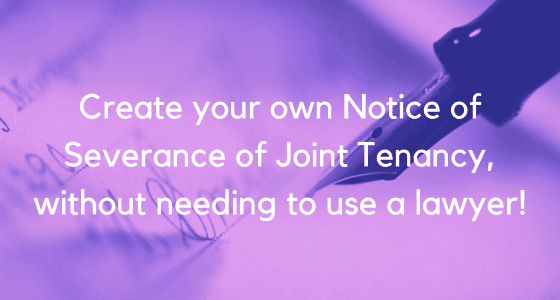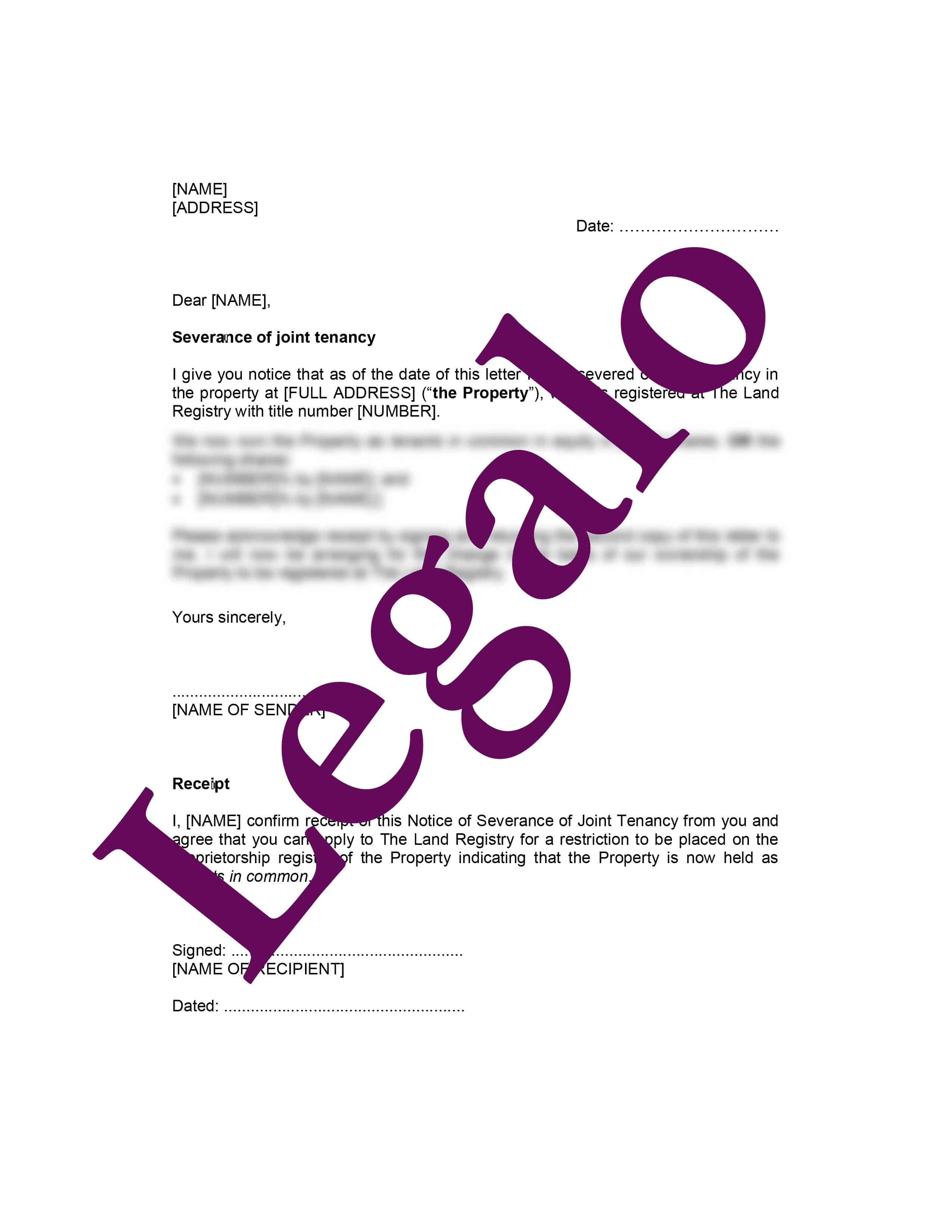Notice of Severance of Joint Tenancy
Our Notice of Severance of Joint Tenancy template:
- Expert UK solicitor-drafted, for peace of mind
- Full written guidance notes included
- Simple plain English
- Easy to edit and complete

How Does It Work?
-
1. Download
-
2. Edit
-
3. Print
-
4. Sign
Our Notice of Severance of Joint Tenancy template is for use by someone who:
- owns a property with another person as “joint tenants” (or “beneficial joint tenants”), and
- who now wishes to change the basis of their ownership to “tenants in common”.
We have drafted the letter to be short and simple. Firstly, you need to sign it and give a copy to the other owner. Secondly, if your property is registered land, you need to register the change in ownership basis at the Land Registry. See the notes near the end of this guide in this regard. For further information see: www.gov.uk/joint-property-ownership/overview.
What is a joint tenancy?
A joint tenancy basis means that if one owner dies, the other owner(s) inherit that share of the property automatically. You cannot leave your share in a joint tenancy property by your will. The transfer of your share takes effect separately when you die. For most people this is best. However, if you want to change this, you need to sever the joint tenancy. Then the property becomes owned on a “tenants in common” basis. You can then leave your share via your will and then there will be no automatic transfer of your share to the other owner when you die (and vice versa). See the section headed “The need for a new Will” below in this regard.
This simple letter allows you to sever the joint tenancy.
Why use a Notice of Severance of Joint Tenancy?
As noted above, there are various reasons you might want to sever the joint tenancy. The 3 most common ones are:
1. Relationship difficulties
If you own a property on a joint tenancy basis with your spouse but you are in relationship difficulties, e.g. separated, but not yet divorced, you might:
(a) sever the joint tenancy and
(b) make a new will.
This is in case one of you dies before you have finalised the divorce (and all the related financial arrangements).
Severing the joint tenancy means that, if you die before you finalise your divorce, your spouse won’t simply inherit your share of it, as your next of kin. It means you could in the meantime make a new will and then be able to leave your share of the property to someone else, e.g. your children. If either of you have started divorce proceedings, the severance has no actual effect on the outcome of them. This is because the two of you still own the property. So it will still be sorted out either by agreement or by the court under its normal rules.
2. Concerns over care home fees
If you are concerned about the payment of future care home fees by the survivor of the two of you, you might sever the joint tenancy.
By (a) severing the joint tenancy, and (b) not leaving your share of the property to the other owner in your will (so long as you have made a will), if the survivor has to go into a care home, the care fees they incur can only be taken out of their share of the property.
Thus you avoid losing the entire value of the home in care fees, and you could leave your share direct to your children for example. (NB Whether the whole of the property is in fact at risk will depend on the law concerning the payment of care fees and whether there are, at the time, any limits on how much of the property the person owns can be taken to pay the care fees.)
You can see in both of the above examples that you sever the joint tenancy AND make a new will.
3. Changing the ownership of investment property
If a couple has an investment property, quite often a husband or wife will decide to gift the other spouse another part of the property. They might be doing this for tax reasons. A gift made between spouses is free of tax. If you held it as joint tenants, you will now need to use the notice of severance to switch this to a tenants-in-common basis. Then file an SEV form to the Land Registry. This will then allow you to hold the property in unequal percentages of your choice.
If you don’t want to change the percentage ownership at the Land Registry with a TR1 form after making this change, then you can use our Bare Trust Deed to have both spouses declare the new ownership basis. Although do still file the SEV form at the Land Registry.
The process for severing a joint tenancy
This is a simple process, but in 2 important steps:
- Write a notice of severance and give it to the other owner(s) – use our template for this; and
- Update your property title at the Land Registry by sending them a form SEV – download this from the Land Registry’s website – use the link below.
For more information on the Land Registry process for this, the address to send it to and a free copy of the form SEV, click on this link. There is no fee to pay the Land Registry for this form or for the registration process.
Once you have done both steps, then you wait for the Land Registry to update your title. NB this may take 6 months or so, as the Land Registry have been very slow since the first Covid-19 lockdown in 2020. The Land Registry will enter a restriction on your title, noting that it is now owned as tenants-in-common.
If both / all owners agree to the severance and sign the form SEV, then you don’t need to send the Land Registry a copy of the notice of severance (but you do still need to have used such a notice in order actually to sever the joint tenancy in the first place, so it is an essential step). However, if not all owners sign the form SEV, then you do need to send either the original of the notice of severance, or a “certified copy” of it, with your form SEV. Any firm of solicitors local to you should certify a copy of your notice for £5 if you need that done. You can find a local firm here: Law Society website.
The need for a new Will after a Notice of Severance of Joint Tenancy
If you use this notice but then have made no will specifying where your share goes and the other owner is your spouse, i.e. your next of kin, there is a risk that they will inherit your share of the property and own it outright, and then you are “back at square one” – The rules of intestacy would apply here if there was no will, with a large portion of your estate normally going to your spouse.
Therefore it is important that, as well as severing the joint tenancy, you make a new will immediately and in it you do not leave your share in the property to your spouse after you have severed your joint tenancy. For our full range of will templates, please click here.
Clauses in this Notice of Severance of Joint Tenancy
Address it at the top to the person you own the property with as joint tenants – usually this will be your spouse. (In the unlikely event that it is more than one person, then put all their names and addresses in here.)
Fill in the date, i.e. the actual date you sign the Notice of Severance of Joint Tenancy.
Below the date, after where it says “Dear”, fill in the name or names of the person(s) to whom you have addressed it . Just as with a normal letter, you can use their first names here if you like.
In the next paragraph fill in (a) the full address of the property in question (with the postcode) and (b) the title number it has at the Land Registry, presuming it is registered land. If it is not registered land, then delete the words “, which is registered at The Land Registry with title number [NUMBER]”.
In the next paragraph if you own the property equally then keep the words “equal shares” and delete the rest of the paragraph and the 2 bullet points below. If not, then instead keep the other option and fill in the percentages you each have and your names in the bullet points below.
Signature clause
Treat this as a simple letter, so finish it off by signing it and stating your name below. Give (or send) 2 copies to the other owner (or to each of the other owners if more than 1 other). You can sign both copies.
Receipt clause
Fill in the name of the recipient in the paragraph and again below where they are to sign. When they sign one copy, they should date it with the date on which they actually sign it.
They should give (or send) that signed one back to you. However, getting a receipted one back from them is not essential (for example if they are not in agreement). You can still proceed with registering the severance notice of joint tenancy at the Land Registry.
Registration of the Notice of Severance of Joint Tenancy
If the property is registered land at the Land Registry, you now need to register this change with the Land Registry. They will note a “restriction” on the title. The procedure you need to follow is as per the following web page: https://www.gov.uk/joint-property-ownership/change-from-joint-tenants-to-tenants-in-common.
You can download the Land Registry form “SEV” you need for free from that web page. There is no fee for registering the Notice of Severance of Joint Tenancy at the Land Registry.
FAQs for a Notice of Severance of Joint Tenancy
Below, we address many of the top questions asked on the Internet about severing a joint tenancy.
How do you sever a joint tenancy UK?
Where you have a joint tenancy ownership basis and you want to convert it to a tenants-in-common basis of ownership, you give a notice to your fellow owners to tell them you are severing the joint tenancy.
Do you need to register severance of joint tenancy?
So that the record of your title deeds is correct at the Land Registry, you should register the severance of your joint tenancy after you have severed the joint tenancy. For more details on this, see the next question and answer.
How do you sever a joint tenancy Land Registry?
If you are looking to sever a joint tenancy, you do need to register it at the Land Registry. To do this you will need to submit an SEV form to the Land Registry after you have severed the tenancy by a notice given to the other owners. The ownership will then convert to a tenancy-in-common, where:
-
each owner has a distinct share; and
-
there is no automatic passing of a deceased owner’s interest to the survivors.
You can find out more about this on the Land Registry’s website.
How do I write a notice of severance?
The easiest way to do this is with a great template from Legalo. Our template is simple to use and cost-effective. A template ensures you use the correct words and it is quick and easy to use, so you don’t waste your time and effort.
What is a memorandum of severance of joint tenancy?
A memorandum of severance of joint tenancy is a legal document that sets out an agreement among co-owners to hold distinct shares of the property, allowing each owner to independently deal with their own share. It severs the joint tenancy and converts it into a tenancy in common. The memorandum usually includes the names of the co-owners, details of the property and the declaration itself of their intention to sever the joint tenancy.
How do you sever a joint tenancy on a property?
You give written notice of the severance to the other owner(s). This notice severs the tenancy immediately, and you do not need either:
-
the agreement or consent of any of the other owners; or
-
any receipt from them to confirm they have received the notice from you.
How do you sever a joint tenancy with right of survivorship?
All joint tenancies feature the right of survivorship. This right means that if one owner dies, then the other owner(s) inherit the deceased’s rights in the property automatically, without the need of any payment or for a Will. All joint tenancies can be severed in the same way: buy a letter or notice of severance to be signed by at least one of the joint owners and to be sent to all the other owners.
Can one person end a joint tenancy UK? How do you sever a joint tenancy without consent?
Yes one person can sever a joint tenancy and no consent of other owners is required. This makes it a very simple process.
How much does it cost to sever a joint tenancy?
There is no cost to severing a joint tenancy in theory. There is no fee to download a form SEV or to pay the Land Registry to register your form SEV. The only small cost is paying for a Legalo template. This makes the process simpler and quicker than trying to write the notice yourself.
Does moving out sever a joint tenancy?
No, moving out of a property does not sever a joint tenancy automatically. A joint tenancy is a legal relationship between co-owners, and simply moving out does not affect that relationship. At least one of the owners must sever a joint tenancy using a written notice or letter and then sending a copy of the notice of severance to each of the other owners.
What is a declaration of severance?
A declaration of severance is the same thing as a notice of severance. It is a short note in writing to state that you are severing the joint tenancy. It is given to all of the other owners of the property.
What are the benefits of severing a joint tenancy?
As explained above, there are a couple of benefits to severing a joint tenancy:
-
if you are not divorced, you can sever the joint tenancy so that your spouse does not automatically inherit your share if you die before the divorce is finalised; and
-
if you have concerns over future care home fees, you can ensure you only expose half the house’s value to them, as explained above.
What is notice of severance of joint tenancy in divorce?
This notice is generally served during divorce proceedings. It makes the change in ownership status clear and ensures that each party holds a definite share in the property. As noted above, severing the joint tenancy during the divorce proceedings ensures that if one party were to die before they finalise the divorce, then the other does not automatically inherit their share of the property. So it is a precautionary action. You should follow it up by spouses making fresh wills to state to whom they want to leave their property. Again, this is so that you do not still end up transferring the property to the surviving spouse by either:
- an existing will; or
- the Intestacy Rules.





